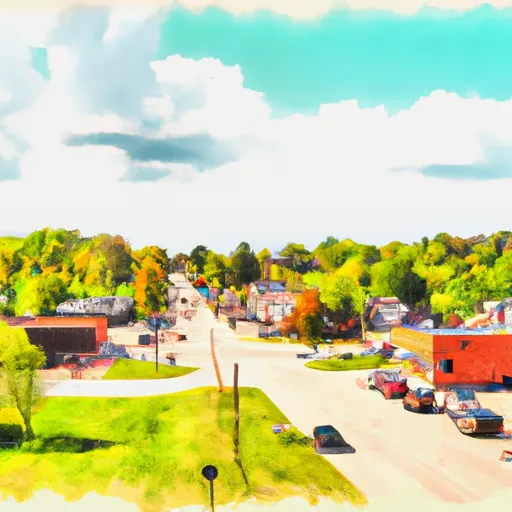-
 Snoflo Premium
Snoflo Premium
Get unlimited access to all our content
With no Ad interruptions! - Start Your Free Trial Login with existing account
Leroy
Eden Index
Climate
6.3
•
Recreation
2.9
•
Community
2.3
•
Safeguard
4.1/10

Leroy, Michigan is a small rural community located in Osceola County. It experiences a humid continental climate, characterized by warm summers and cold winters. Average temperatures range from the mid-20s (-4°C) in January to the mid-70s (24°C) in July. The region receives ample rainfall throughout the year, with an average of 30 inches (76 cm) annually, ensuring lush vegetation and vibrant landscapes.
Leroy is nestled in an area with abundant hydrological constituents. The town is surrounded by numerous small lakes and rivers, making it a paradise for fishing enthusiasts. Big Star Lake, Diamond Lake, and the Middle Branch River are popular spots for catching bass, walleye, and trout. These water bodies also offer opportunities for boating, kayaking, and swimming.
Outdoor recreation opportunities in Leroy are plentiful. The nearby Pere Marquette State Forest provides ample opportunities for hiking, camping, and wildlife viewing. The White Pine National Golf Resort offers a picturesque 18-hole golf course for golfers of all skill levels. Additionally, the Huron-Manistee National Forest, located a short drive away, offers further opportunities for hiking, hunting, and camping in a beautiful natural setting.
In Leroy, Michigan, residents and visitors alike can enjoy the area's pleasant climate, abundant water resources, and a variety of outdoor activities throughout the year.
What is the Eden Index?
The Snoflo Eden Index serves as a comprehensive rating system for regions, evaluating their desirability through a holistic assessment of climate health, outdoor recreation opportunities, and natural disaster risk, acknowledging the profound impact of these factors on livability and well-being.
Climate Health Indicator (CHI): 6.3
Leroy receives approximately
864mm of rain per year,
with humidity levels near 82%
and air temperatures averaging around
7°C.
Leroy has a plant hardyness factor of
5, meaning
plants and agriculture in this region thrive during a short period during spring and early summer. Most
plants will die off during the colder winter months.
By considering the ideal temperature range, reliable water supplies, clean air, and stable seasonal rain or snowpacks, the Climate Health Indicator (CHI) underscores the significance of a healthy climate as the foundation for quality living.
A healthy climate is paramount for ensuring a high quality of life and livability in a region, fostering both physical well-being and environmental harmony. This can be characterized by ideal temperatures, reliable access to water supplies, clean air, and consistent seasonal rain or snowpacks.
Weather Forecast
Streamflow Conditions
Northeastern Lake Michigan
Area Rivers
Northeastern Lake Michigan
Snowpack Depths
Northeastern Lake Michigan
Reservoir Storage Capacity
Northeastern Lake Michigan
Groundwater Levels
Recreational Opportunity Index (ROI): 2.9
The Recreational Opportunity Index (ROI) recognizes the value of outdoor recreational options, such as parks, hiking trails, camping sites, and fishing spots, while acknowledging that climate plays a pivotal role in ensuring the comfort and consistency of these experiences.
Access to outdoor recreational opportunities, encompassing activities such as parks, hiking, camping, and fishing, is crucial for overall well-being, and the climate plays a pivotal role in enabling and enhancing these experiences, ensuring that individuals can engage in nature-based activities comfortably and consistently.
Camping Areas
| Campground | Campsites | Reservations | Toilets | Showers | Elevation |
|---|---|---|---|---|---|
| Bixler Lake City Campground | 100 | 965 ft | |||
| Mouth of Two Hearted River - State Forest | 39 | 615 ft | |||
| Holland Lake - State Forest | 15 | 760 ft | |||
| High Bridge - State Forest | 7 | 720 ft | |||
| Chain OLakes State Park | 410 | 956 ft | |||
| Pretty Lake - State Forest | 27 | 761 ft | |||
| Muskallonge Lake State Park | 170 | 644 ft | |||
| Culhane Lake - State Forest | 22 | 635 ft | |||
| Bodi Lake - State Forest | 20 | 650 ft | |||
| Hidden Diamonds City Park | None | 901 ft |
Nearby Ski Areas
Catastrophe Safeguard Index (CSI):
The Catastrophe Safeguard Index (CSI) recognizes that natural disaster risk, encompassing floods, fires, hurricanes, and tornadoes, can drastically affect safety and the overall appeal of an area.
The level of natural disaster risk in a region significantly affects safety and the overall livability, with climate change amplifying these risks by potentially increasing the frequency and intensity of events like floods, fires, hurricanes, and tornadoes, thereby posing substantial challenges to community resilience and well-being.
Community Resilience Indicator (CRI): 2.3
The Community Resilience Indicator (CRI) recognizes that education, healthcare, and socioeconomics are crucial to the well-being of a region. The CRI acknowledges the profound impact of these elements on residents' overall quality of life. By evaluating educational resources, healthcare accessibility, and economic inclusivity, the index captures the essential aspects that contribute to a thriving community, fostering resident satisfaction, equity, and social cohesion.

